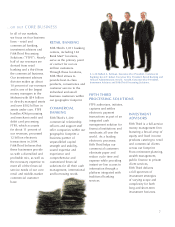Fifth Third Bank 2004 Annual Report Download - page 19
Download and view the complete annual report
Please find page 19 of the 2004 Fifth Third Bank annual report below. You can navigate through the pages in the report by either clicking on the pages listed below, or by using the keyword search tool below to find specific information within the annual report.MANAGEMENT’S DISCUSSION AND ANALYSIS OF FINANCIAL CONDITION AND RESULTS OF OPERATIONS
Fifth Third Bancorp 17
loan category.
Historical loss rates for commercial and consumer loans may
be adjusted for signifi cant factors that, in management’s judgment,
refl ect the impact of any current conditions on loss recognition.
Factors that management considers in the analysis include the
effects of the national and local economies, trends in the nature and
volume of loans (delinquencies, charge-offs and nonaccrual loans),
changes in mix, credit score migration comparisons, asset quality
trends, risk management and loan administration, changes in the
internal lending policies and credit standards, collection practices
and examination results from bank regulatory agencies and the
Bancorp’s internal credit examiners.
An unallocated reserve is maintained to recognize the impreci-
sion in estimating and measuring loss when evaluating reserves for
individual loans or pools of loans. Reserves on individual loans and
historical loss rates are reviewed quarterly and adjusted as necessary
based on changing borrower and/or collateral conditions and actual
collection and charge-off experience.
The Bancorp’s primary market areas for lending are Ohio,
Kentucky, Indiana, Michigan, Illinois, Florida, Tennessee, West
Virginia and Pennsylvania. When evaluating the adequacy of
reserves, consideration is given to this regional geographic concen-
tration and the closely associated effect changing economic condi-
tions have on the Bancorp’s customers.
The Bancorp has not substantively changed any aspect to its
overall approach in the determination of the reserve for loan and
lease losses. There have been no material changes in assumptions or
estimation techniques as compared to prior periods that impacted
the determination of the current period reserve for loan and lease
losses. As of December 31, 2004, the reserve for unfunded commit-
ments has been reclassifi ed from the reserve for loan and lease losses
to other liabilities. The December 31, 2003 reserve for unfunded
commitments and all subsequent activity has been reclassifi ed to
conform to current period presentation.
Valuation of Servicing Rights
When the Bancorp sells loans through either securitizations or indi-
vidual loan sales in accordance with its investment policies, it may
retain servicing rights. Servicing rights resulting from loan sales
are amortized in proportion to and over the period of estimated
net servicing revenues. Servicing rights are assessed for impairment
monthly, based on fair value, with temporary impairment recog-
nized through a valuation allowance and permanent impairment
recognized through a write-off of the servicing asset and related
valuation reserve. Key economic assumptions used in measuring
any potential impairment of the servicing rights include the prepay-
ment speeds of the underlying loans, the weighted-average life of
the loan, the discount rate, the weighted-average coupon and the
weighted-average default rate, as applicable. The primary risk of
material changes to the value of the servicing rights resides in the
potential volatility in the economic assumptions used, particularly
the prepayment speeds. The Bancorp monitors risk and adjusts
its valuation allowance as necessary to adequately reserve for any
probable impairment in the portfolio. For purposes of measuring
impairment, the servicing rights are stratifi ed based on the fi nancial
asset type and interest rates. In addition, the Bancorp obtains an
independent third-party valuation of the mortgage servicing rights
(“MSR”) portfolio on a quarterly basis. Fees received for servicing
loans owned by investors are based on a percentage of the outstand-
ing monthly principal balance of such loans and are included in
noninterest income as loan payments are received. Costs of servic-
ing loans are charged to expense as incurred.
The change in the fair value of MSRs at December 31, 2004,
due to immediate 10% and 20% adverse changes in the current
prepayment assumptions would be a decrease of approximately $18
million and $33 million, respectively and due to immediate 10%
and 20% favorable changes in the current prepayment assumption
would be approximately $19 million and $40 million, respectively.
The change in the fair value of the MSR portfolio at December
31, 2004, due to immediate 10% and 20% adverse changes in the
discount rate assumptions would be a decrease of approximately $10
million and $18 million, respectively and due to immediate 10%
and 20% favorable changes in the discount rate assumption would
be approximately $10 million and $20 million, respectively. Sensi-
tivity analysis related to other consumer and commercial servicing
rights is not material to the Bancorp’s Consolidated Financial State-
ments. These sensitivities are hypothetical and should be used with
caution. As the fi gures indicate, change in fair value based on a 10%
and 20% variation in assumptions typically cannot be extrapolated
because the relationship of the change in assumptions to change
in fair value may not be linear. Also, the effect of a variation in
a particular assumption on the fair value of the retained interests
is calculated without changing any other assumption; in reality,
changes in one factor may result in changes in another, which might
magnify or counteract the sensitivities.
Securities
Securities are classifi ed as held-to-maturity, available-for-sale or
trading on the date of purchase. Only those securities classifi ed as
held-to-maturity, and which management has both the intent and
ability to hold to maturity, are reported at amortized cost. Available-
for-sale and trading securities are reported at fair value with unreal-
ized gains and losses, net of related deferred income taxes, included
in accumulated other comprehensive income on the Consolidated
Balance Sheets and noninterest income in the Consolidated State-
ments of Income, respectively. The fair value of a security is deter-
mined based on quoted market prices. If quoted market prices are
not available, fair value is determined based on quoted prices of
similar instruments. Realized securities gains or losses are report-
ed within noninterest income in the Consolidated Statements of
Income. The cost of securities sold is based on the specifi c identi-
fi cation method. Available-for-sale and held-to-maturity securities
are reviewed quarterly for possible other-than-temporary impair-
ment. The review includes an analysis of the facts and circumstanc-
es of each individual investment such as the severity of loss, the
length of time the fair value has been below cost, the expectation
for that security’s performance, the creditworthiness of the issuer
and the Bancorp’s intent and ability to hold the security. A decline
in value that is considered to be other-than-temporary is recorded
as a loss within noninterest income in the Consolidated Statements
of Income. At December 31, 2004, 94% of the unrealized losses in
the available-for-sale security portfolio were comprised of securities
issued by U.S. Treasury and Government agencies, U.S. Govern-
ment sponsored agencies and states and political subdivisions as
well as agency mortgage-backed securities. The Bancorp believes
the price movements in these securities are dependent upon the
movement in market interest rates particularly given the negligible
inherent credit risk for these securities. The Bancorp also maintains
its intent and ability to hold these securities.
























